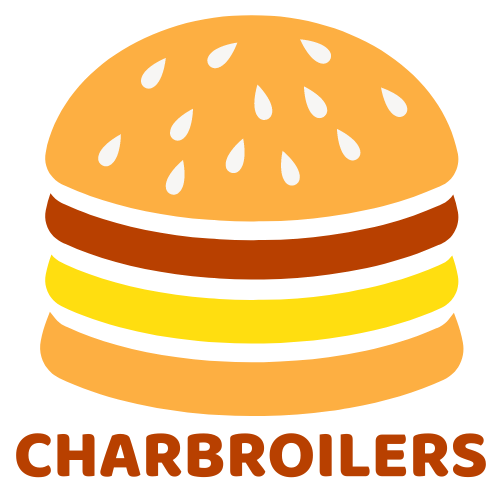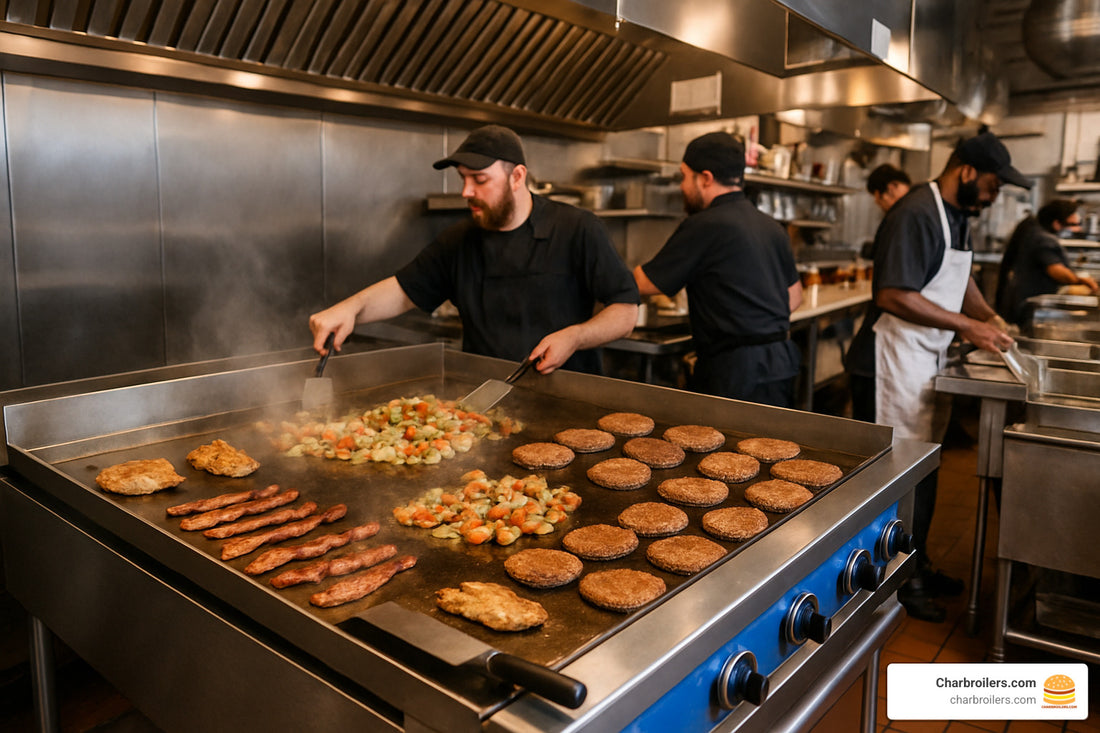
48 Inch Commercial Flat Top Grill Guide – Cooking Up Success
Share
The Ultimate Workhorse for High-Volume Kitchens
A 48 inch commercial flat top grill is the backbone of many busy foodservice operations, offering expansive cooking space and consistent performance for high-volume meal production. If you're looking to purchase one of these kitchen workhorses, here's what you need to know:
| Quick Facts: 48 Inch Commercial Flat Top Grill |
|---|
| Cooking Surface: 48" × 20-24" (960-1,152 square inches) |
| Typical BTU Output: 113,200-120,000 BTU (gas models) |
| Heating Zones: 4 independently controlled sections |
| Plate Thickness: 3/4" to 1" (thicker = better heat retention) |
| Temperature Range: 150°F to 500°F |
| Price Range: $1,049 (entry-level) to $8,000+ (premium) |
| Weight: 340-360 pounds |
These robust cooking stations are the secret behind a restaurant's ability to handle breakfast rushes with pancakes and eggs, lunch crowds demanding burgers and sandwiches, and dinner service requiring seared proteins and vegetables—all with consistent results.
The 48 inch commercial flat top grill stands out from smaller models by providing enough space to create multiple temperature zones, allowing you to simultaneously prepare different menu items without flavor transfer or temperature fluctuations. Most models feature four independently controlled burners, each delivering between 28,000 and 30,000 BTU, ensuring rapid heat recovery even during the busiest service periods.
I'm Sean Kearney from Charbroilers.com, with over a decade of restaurant equipment experience including helping hundreds of operators select the right 48 inch commercial flat top grill for their specific kitchen needs. After testing dozens of models across various price points, I've seen how the right griddle can transform a kitchen's efficiency and food quality.
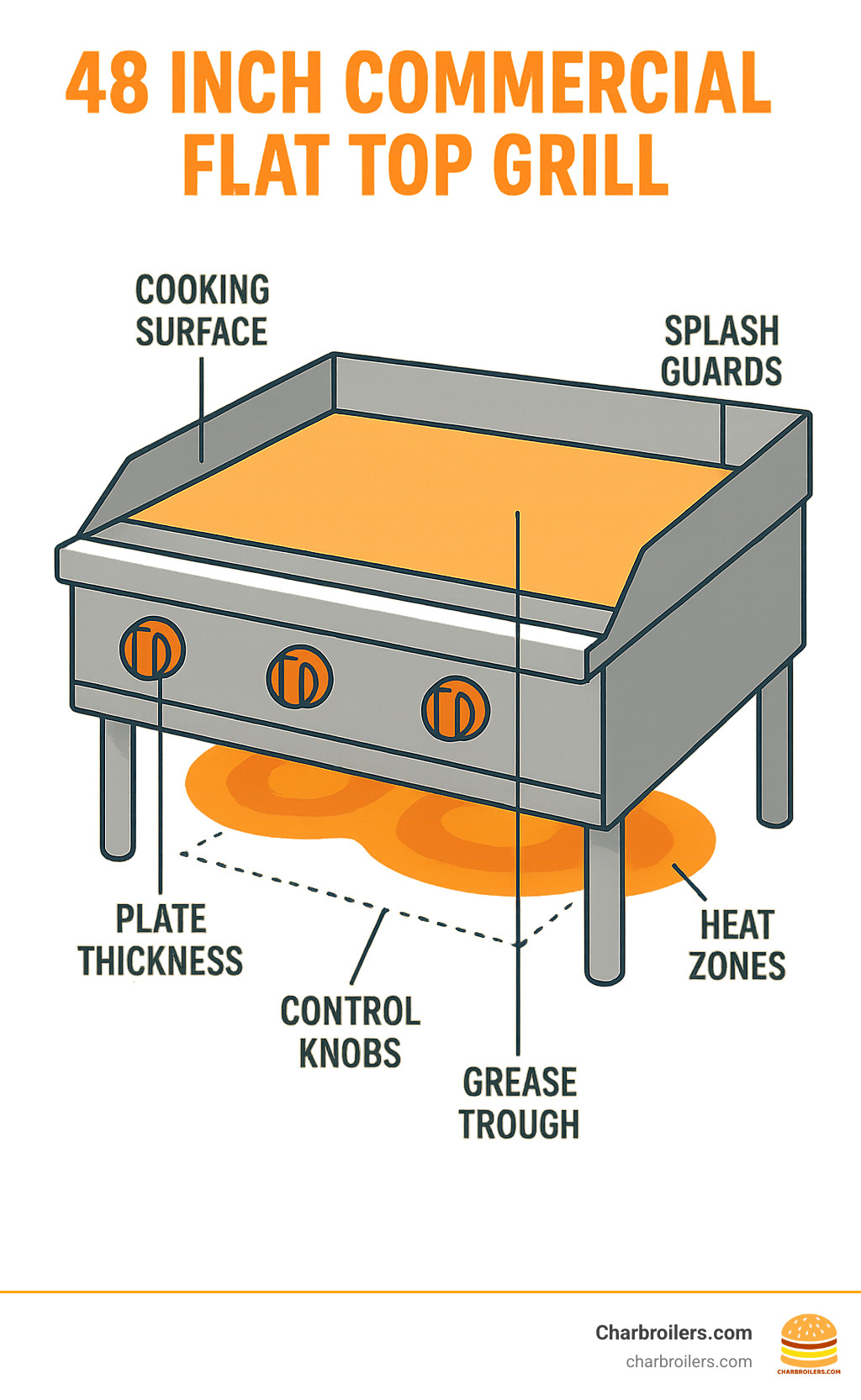
Understanding the 48 Inch Commercial Flat Top Grill
Picture walking into a busy restaurant kitchen during the morning rush—that sizzling sound you hear likely comes from a 48 inch commercial flat top grill. These kitchen powerhouses are essentially large, flat cooking surfaces heated from below, changing ordinary ingredients into mouthwatering meals with remarkable efficiency.
When we talk about these griddles, we're describing a substantial piece of equipment. The cooking surface spans a generous 48 inches wide by 20-24 inches deep, giving your kitchen staff between 960 and 1,152 square inches of cooking real estate. That's enough space to simultaneously cook 40+ burger patties, 60+ pancakes, or 30+ grilled cheese sandwiches—perfect for those moments when every table in your restaurant fills up at once!
Most 48 inch commercial flat top grills feature four independently controlled heating zones, each with its own burner. Gas models pack a serious punch, delivering between 28,000 and 30,000 BTU per burner for a total output of 113,200 to 120,000 BTU. This impressive power ensures your cooking surface heats quickly and recovers temperature almost instantly, even when loaded with food.
Built to withstand the demands of commercial kitchens, these units carry important safety certifications like ETL and UL. Their substantial weight (340-360 pounds) reflects the heavy-duty construction designed to provide years of reliable service even in the most demanding kitchens.
What Makes a "48 Inch Commercial Flat Top Grill" Different?
The 48 inch commercial flat top grill isn't just a bigger version of smaller models—it's a different cooking experience altogether. With four distinct heating zones, you can create a culinary playground across the cooking surface. Imagine searing steaks at 450°F on one end while gently warming tortillas at 200°F on the other—all on the same piece of equipment!
This expanded capacity dramatically increases your kitchen's throughput during peak service periods. When Saturday morning breakfast hits and everyone wants pancakes, eggs, and hash browns simultaneously, your 48 inch commercial flat top grill becomes your kitchen's hero.
You'll find these units available in both countertop and floor configurations. Countertop models save valuable floor space but require sturdy support given their substantial weight. Floor models include convenient storage underneath but take up more of your kitchen's footprint.
Ideal Applications Across Foodservice
The remarkable versatility of a 48 inch commercial flat top grill makes it the Swiss Army knife of commercial kitchens:
In restaurants, these griddles handle everything from breakfast eggs and pancakes to lunch burgers and dinner proteins with consistent results day after day. Food trucks maximize their limited space with this single piece of equipment that can prepare most menu items efficiently—from quesadillas to cheesesteaks.
Catering operations rely on these workhorses to provide high-volume cooking capability for large events, preparing diverse menu items simultaneously to keep the serving line moving. Hotel kitchens support both à la carte service and elaborate buffet operations with rapid cooking and reliable holding capabilities.
Key Buying Factors: Fuel, Controls, Plate & Power
Let's face it—choosing the right 48 inch commercial flat top grill feels a bit like picking a car. You wouldn't buy a sports car to haul equipment, right? The same thinking applies here. Four critical factors will make or break your kitchen's performance: what powers it, how you control it, what you cook on, and how much power it packs.
Fuel Source & Energy Requirements
Your 48 inch commercial flat top grill will run on one of two things: gas or electricity. Each has its own personality in the kitchen:
Gas models connect to your kitchen with a 3/4" gas line and offer that quick-heating performance many chefs swear by. Most can switch between natural gas and propane (though please, leave that job to the professionals). Gas griddles heat up faster than their electric cousins and bounce back quickly when you throw a dozen frozen burger patties on them. The trade-off? You'll need proper ventilation, and they'll pump out a substantial 113,200-120,000 BTUs of heat.
Electric models need 208/240V connections and draw between 10,500-14,000 watts. They're the precision instruments of the griddle world—heating more evenly across the surface with temperature control that's more "scientific laboratory" than "cooking by feel." They're typically more energy-efficient but recover more slowly during a rush. The big advantage? You can install them in spaces where running gas lines isn't practical or permitted.
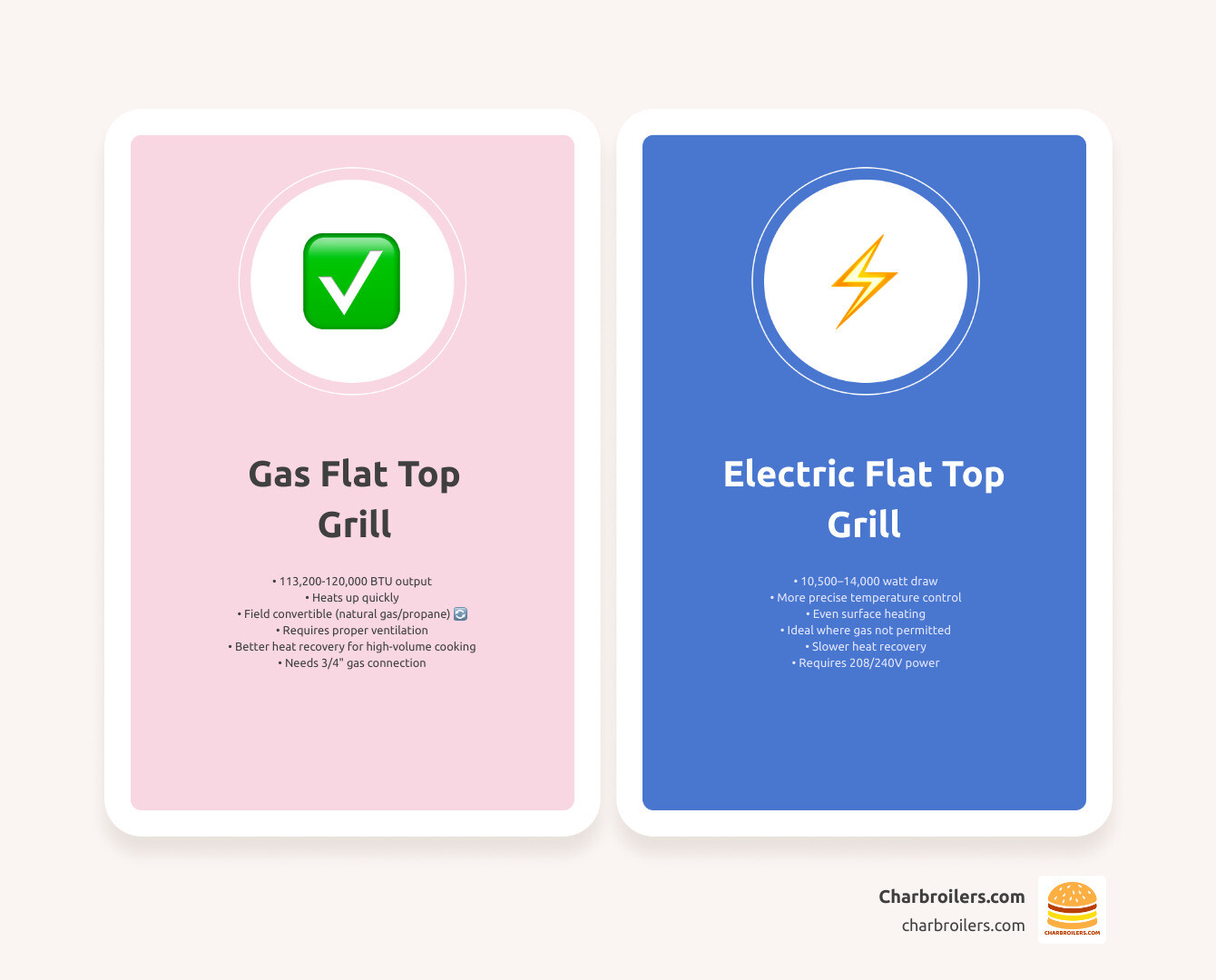
Worth noting for our mountain-dwelling friends: if your restaurant sits above 2,000 feet elevation, you'll need special adjustments for gas equipment. The thinner air affects combustion, so always mention your elevation when ordering your 48 inch commercial flat top grill.
Control Systems: Manual vs Thermostatic
The brains of your griddle operation comes down to manual or thermostatic controls—essentially the difference between driving stick shift or automatic.
Manual controls are the old-school approach—simpler, fewer parts to break, and typically cheaper upfront. They're perfect for experienced cooks who can tell temperature by hovering their hand over the surface or watching how water dances when flicked onto the griddle.
Thermostatic controls are like having a sous chef dedicated to temperature management. They use embedded thermostats to monitor and maintain precise temperatures automatically. Most quality 48 inch commercial flat top grills feature one thermostat per 12" section, giving you four distinct cooking zones. While they cost more initially, they deliver consistency that's hard to beat—especially when you're training new staff.
Plate Thickness & Heat Performance
The cooking surface itself comes in different thicknesses, typically 3/4" or 1". This might seem like a small difference, but it's like choosing between a light jacket or a heavy coat for winter.
The 3/4" plate warms up faster (usually 15-20 minutes) and weighs less. It's the sprinter of the griddle world—quick off the blocks but might get winded during a marathon service.
The 1" plate is the marathon runner—takes longer to warm up (typically 25-30 minutes) but maintains rock-solid temperatures when slammed with orders. The extra mass stores more heat energy, distributes it more evenly, and resists warping over years of service.
According to research from the Food Service Technology Center, thicker plates can improve energy efficiency by up to 15% during high-volume cooking periods, despite requiring more initial energy to heat up.
Performance Comparison of Leading 48-Inch Models
Shopping for a 48 inch commercial flat top grill can feel overwhelming with so many options on the market. Let's break down what separates the good from the great, and help you understand exactly what your money buys at different price points.
Side-by-Side Specs for 48 Inch Commercial Flat Top Grill Options
I've spent countless hours working with these griddles, and trust me—the differences matter when you're in the middle of a Saturday night rush. Entry-level models will get the job done, but premium griddles truly shine when the pressure's on.
| Feature | Entry-Level | Mid-Range | Premium |
|---|---|---|---|
| Plate Thickness | 3/4" | 3/4" - 1" | 1" |
| BTU Output (Gas) | 100,000-113,200 | 113,200-120,000 | 120,000+ |
| Control Type | Manual | Thermostatic | Modulating Thermostatic |
| Temp Range | 200°-450°F | 150°-500°F | 150°-550°F |
| Heat Zones | 2-4 | 4 | 4-6 |
| Recovery Time | Moderate | Good | Excellent |
| Warranty | 1 Year Parts | 1-2 Years Parts/Labor | 2+ Years Parts/Labor |
| Construction | Stainless Front | Stainless Front/Sides | All Stainless |
| Price Range | $1,049-$2,500 | $2,500-$5,000 | $5,000-$8,000+ |
When checking out a potential griddle, always look for proper safety certifications. A quality 48 inch commercial flat top grill should carry ETL, UL, or NSF listings—these aren't just fancy acronyms, but your assurance that the equipment meets rigorous industry standards for safety and performance.
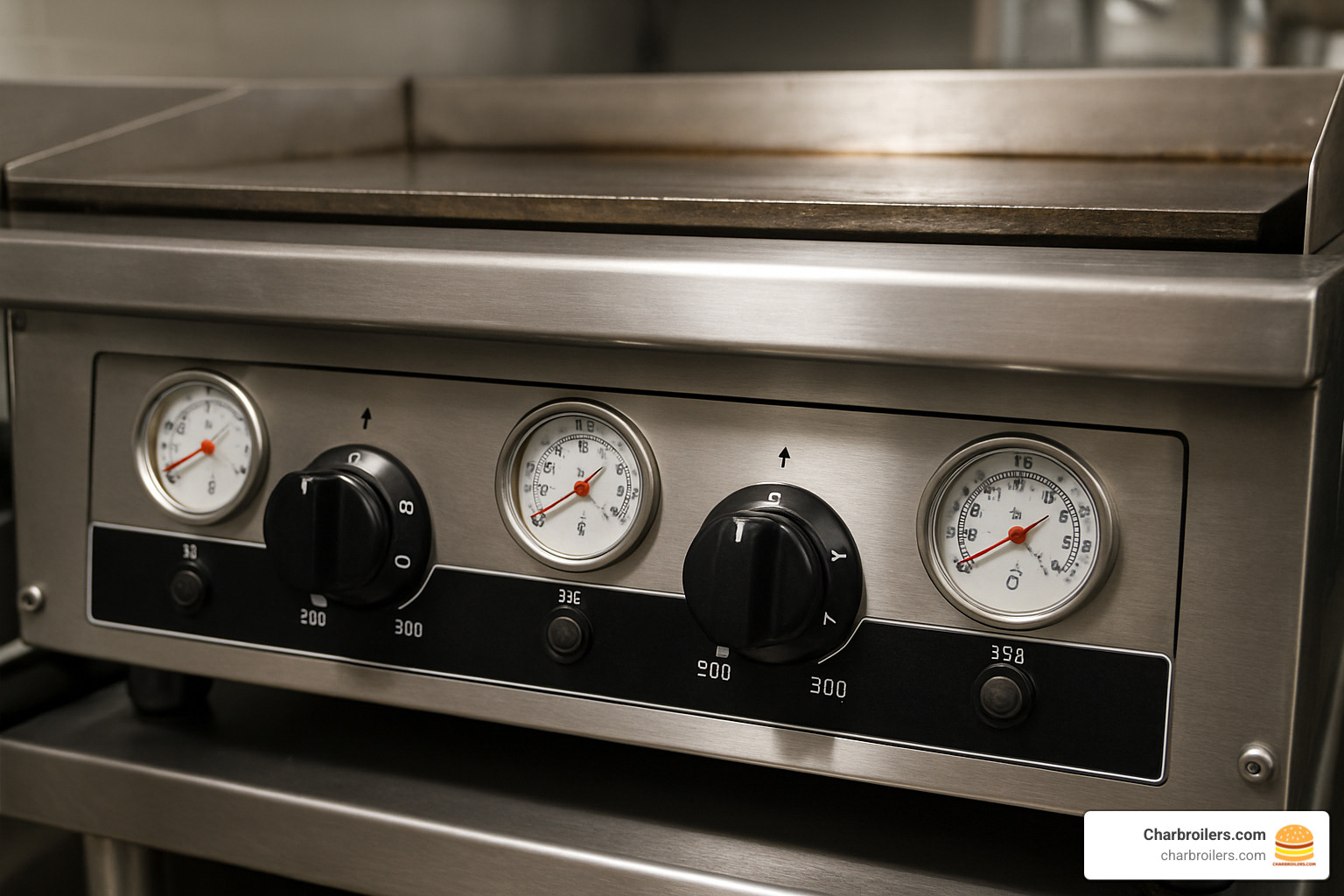
Typical Price Tiers & What You Get
The price spectrum for a 48 inch commercial flat top grill starts around $1,049 and can climb beyond $8,000. Here's a real-world breakdown of what each price range delivers:
Entry-level models ($1,049-$2,500) offer the basics—a 3/4" cooking plate, manual or simple thermostatic controls, and typically just the front panel in stainless steel with painted sides. The warranty usually covers parts only for a year. These workhorses are perfect for lower-volume kitchens or as backup equipment.
Step up to mid-range options ($2,500-$5,000), and you'll notice significant improvements. The cooking plate thickens to between 3/4" and 1", controls become more sophisticated with better zone management, and you'll get stainless steel on both the front and sides. Warranties typically extend to 1-2 years and include labor.
Premium griddles ($5,000-$8,000+) are built for the busiest kitchens where failure isn't an option. They feature 1" or composite cooking plates that maintain heat beautifully, advanced modulating thermostatic controls for precision cooking, and all-stainless construction that stands up to years of abuse. Many include specialized technologies like infrared burners, and warranties often extend beyond two years with full parts and labor coverage.
Maintenance, Safety & Must-Have Accessories
Keeping your 48 inch commercial flat top grill in prime condition isn't just about preserving your investment—it's about ensuring consistent food quality and safety for your customers.
Routine Cleaning & Troubleshooting
The secret to a long-lasting griddle is surprisingly simple: daily love and attention. At the end of each shift, while your griddle is still warm (but not hot enough to burn you!), scrape off food particles and apply water or an approved cleaning solution. Work in circular motions with a griddle brick, rinse thoroughly, and finish with a thin layer of cooking oil to prevent rust. Don't forget to empty that grease drawer!
Once a week, your 48 inch commercial flat top grill deserves a deeper cleaning. Heat it to around 300°F, then let it cool slightly before applying a commercial cleaner. After a thorough scrubbing with a griddle brick, neutralize with a vinegar solution, rinse with water, and re-season with oil. This ritual keeps flavors pure and heat distribution even.
When things aren't working quite right, troubleshooting is fairly straightforward. Uneven heating often comes down to improper leveling or gas pressure issues. Those stubborn carbon deposits that make food stick? A griddle screen during deep cleaning works wonders. If your thermostats seem to be lying about the temperature, it's time for professional calibration.
Chrome plate models require special attention—never use abrasive tools that can damage the surface. Instead, clean with manufacturer-recommended solutions while the surface is still warm, and always use plastic or wooden tools during cooking.
Recommended Accessories for Peak Performance
The right accessories can transform your 48 inch commercial flat top grill from a good cooking surface into a high-performance culinary powerhouse. A proper equipment stand not only positions your countertop model at the perfect working height but provides valuable storage underneath for pans and tools.
High-quality spatulas, scrapers, and cleaning tools designed specifically for commercial griddles make a world of difference in both cooking and maintenance. Many of our customers swear by splash guard extensions that prevent grease from decorating your cooks' uniforms during busy service.

Safety is never an afterthought with commercial cooking equipment. Today's 48 inch commercial flat top grills come equipped with crucial safety features like pilot safety valves that automatically shut off gas flow if the pilot light goes out, and over-temperature protection to prevent dangerous overheating. Look for models with ETL Sanitation certification, flame failure protection, and cool-touch front panels that reduce burn risks during busy service.
For more detailed information on maintaining commercial kitchen equipment, check out this comprehensive guide from the National Restaurant Association on equipment maintenance best practices.
Choosing the Right 48" Flat Top Grill for Your Business
Finding the perfect 48 inch commercial flat top grill feels a bit like dating – you need the right match for your specific needs and situation. After helping hundreds of restaurant owners make this important decision, I've learned that taking time to consider a few key factors can save you thousands in the long run.
Decision Checklist for 48 Inch Commercial Flat Top Grill Buyers
Start by thinking about what you'll actually be cooking. Are you flipping pancakes and eggs for the breakfast crowd, or searing steaks during dinner rush? Your menu directly impacts the type of griddle you need. A busy diner might require different features than an upscale steakhouse.
Volume matters tremendously. During your busiest hour, how many orders will hit the kitchen? If you're regularly serving 100+ customers in a rush, you'll need a griddle with excellent recovery time and possibly a thicker plate. A 48 inch commercial flat top grill can handle about 40 burgers or 60 pancakes at once – is that enough for your operation?
Kitchen space isn't just about whether the griddle will fit – it's about whether your space can properly support it. These units weigh between 340-360 pounds, so that countertop better be sturdy! Floor models give you storage underneath but take up valuable floor space. Either way, proper ventilation is non-negotiable.
Your available utilities might narrow your choices considerably. No natural gas line? You'll need propane or electric. For gas models, you'll need a 3/4" connection with adequate pressure. If you're considering electric, check if your electrical system can handle a 10.5-14 kW draw.
The experience level of your staff should influence your control system choice. Newer cooks typically perform better with thermostatic controls that maintain precise temperatures automatically. Experienced chefs might prefer the responsiveness of manual controls.
Budget considerations go beyond just the purchase price. A $2,500 griddle might seem expensive compared to a $1,049 model, but if it uses 15% less energy and lasts three years longer, the math favors the pricier option.
Installation planning is crucial for safety and performance. You'll need:
- At least 6 inches of clearance from combustible materials
- A proper hood system with adequate ventilation
- Correctly sized gas lines or electrical capacity
- A perfectly level, sturdy mounting surface
- Enough space around the unit for cleaning and maintenance
Getting Fired Up About Commercial Charbroilers isn't just about buying equipment – it's about finding the right tools to help your culinary vision come to life. Take your time, ask plenty of questions, and choose a griddle that will support your business for years to come.
Frequently Asked Questions about 48 Inch Commercial Flat Top Grills
How much food can I cook at once on a 48" flat top?
On a 48 inch commercial flat top grill with a 24" depth, you're working with an impressive 1,152 square inches of cooking real estate. To put that in perspective, you could simultaneously cook:
- 40-45 hamburger patties
- 60-70 pancakes for the breakfast rush
- 30-35 grilled cheese sandwiches
- 80-100 eggs for your Sunday brunch service
- 24-30 steaks for dinner service
The beauty of having four independent heating zones is that you can prepare omelets on one side while searing steaks on another – without any flavor transfer or temperature compromises. It's like having four separate cooking surfaces in one powerful package!
What is the difference between thermostatic and manual controls?
Think of manual controls as driving a car without cruise control – they work perfectly fine, but require more attention and skill. With manual controls, you're adjusting the flame intensity rather than setting a specific temperature. They're simpler mechanically (which means fewer things to break down) and cost less upfront, but they demand experienced hands who can judge cooking temperatures by sight and touch.
Thermostatic controls, on the other hand, are like having that cruise control – they maintain your desired temperature automatically. They use embedded sensors to monitor the actual surface temperature and adjust the heat accordingly. They come in two flavors: snap-action (which turn the heat on and off to maintain temperature) and modulating (which continuously adjust heat output for pinpoint accuracy).
How often should I season and deep-clean the plate?
You'll want to season your griddle before its very first use, then maintain that seasoning with a quick application after each daily cleaning. If you've done a deep clean or notice food starting to stick, it's time for a re-seasoning session.
The seasoning process is straightforward: heat your griddle to about 350°F, apply a thin layer of high-smoke-point oil like canola or sunflower, let it smoke slightly, then wipe away the excess. For initial seasoning, repeat this 2-3 times to build up a good protective layer.
As for deep cleaning, your cooking volume and menu dictate the frequency. If you're a breakfast-only spot with light use, once a week might suffice. Medium-volume operations should aim for 2-3 times weekly, while high-volume kitchens cooking sticky, sugary, or heavily marinated foods might need daily deep cleans to prevent carbon buildup and flavor transfer.
Conclusion
A 48 inch commercial flat top grill isn't just another piece of equipment—it's the beating heart of many successful kitchens. This workhorse can transform your operation's efficiency, menu capabilities, and overall food quality when you choose the right one.
After exploring all the details, here's what matters most when making your decision:
First, be honest about your needs. That beautiful high-end griddle might catch your eye, but if your menu and volume don't demand its capabilities, you might be better served with a mid-range model. Match the plate thickness, BTU output, and control systems to what you'll actually be cooking day in and day out.
Think beyond the price tag. Yes, that entry-level model might be easier on your initial budget, but premium units often pay for themselves through better energy efficiency, fewer repairs, and longer service life. Sometimes spending a bit more upfront means spending much less over the lifetime of the equipment.
Don't cut corners on installation. Whether you're connecting to gas lines or electrical systems, proper setup according to local codes isn't just about compliance—it's about safety and performance. A properly installed 48 inch commercial flat top grill will run more efficiently and reliably.
Commit to maintenance from day one. Even the finest griddle will deteriorate quickly without proper care. That daily cleaning routine and regular deep cleaning might seem tedious, but they're investments in your equipment's longevity and your food's quality.
At Charbroilers.com, we've helped countless foodservice operations find their perfect match in commercial cooking equipment. We understand that for many businesses, financing makes more sense than a large upfront purchase, which is why we offer flexible options to help you get the equipment you need.
Your griddle isn't just an expense—it's a profit center. It's where your menu comes to life, where consistency happens, and where your kitchen's reputation is built one perfectly cooked item at a time. Choose wisely, maintain diligently, and your 48 inch commercial flat top grill will serve your business faithfully through countless rushes and service periods.
